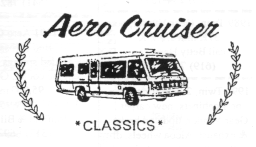Quick Links:
> Members Page
> Organization
> Rally Page
> Picture Page
> News Letters
> Swap Shop
> AC Group
on Google
< Back to the
Club's Public
Page
|
All tips or articles pertaining
to the running gear of the Aero Cruiser. This includes all of the truck components from
Chrysler, the engine, transmission, Gear Vender, rear-axle, tag-axle, differential,
brakes, chassis and suspensions.
Everything in the dashboard, including the truck air conditioning and electrical system
and all other components connected to the truck battery.
Sub Categories:
Click on the
 to
go to its Sub Category: to
go to its Sub Category: |
 |
Engine and its Maintenance: everything not part of one of the three
Engine sub-systems below.
|
 |
Engine's Fuel / Air System: Carburetor, Fuel Injectors,
Pressure Regulator, Air Cleaner. (see below for Gas tank)
|
 |
Engine's Emission System: Emissions Sticker, Smog Test, Smog Pumps, EGR Valve, Oxygen Sensor.
(see below for Exhaust system)
|
 |
Engine's Cooling System:
Radiator, Water Pump, Thermostat, Temperature Sensor, Coolant Recovery Bottle.
|
 |
Drive Train: Transmission, Gear Vender, Rear-axles and Differential
|
 |
Wheels and Chassis: Hubcaps, Wheels, Tires, Brakes, Air Bags, Chassis,
Shocks and Suspension.
|
 |
Everything in the Dashboard:
Truck Air Conditioning, the Truck Electrical System, Fuse block, Switched, Relays
and other dash components from Chrysler.
|
 |
Front Hood: All other components connected to the Truck Battery like
the Air Pump and Wiring panel or under the Front Hood and behind the Grill.
|
 |
For the Gas tank, Exhaust system and
Catalytic Converter see
"External, Under the Coach"
(This is an off page link)
|
-- Disclaimer --Information
on this Web Site is provided by members of the "Aero Cruiser Classics" Motor home Club. All
information on this site is contributed by the club members or outside sources and is believed to be reliable; however,
there is no warranty or guarantee that said information or advice is correct or free of defect. It is
offered on a best effort basis and is to be used at your own risk.
Tips:
Subject: Chrysler "Check
Engine" Light Computer Codes
Tip: From the -- http://www.allpar.com/fix/80s-codes.html
-- web site come the following 1980s-1990s Chrysler Computer Codes. It may or
may not be complete. If you know of a better list, let me know, Tom Heald tom@fl-ink.com
To read the code:
- Start with the ignition off. Within five seconds, switch the key on, off, on, off, on. (On is *not* start!)
- The "check engine" light will flash. Count the flashes Each code is a two digit code, so a (for example) 23 would be FLASH FLASH (pause) FLASH FLASH FLASH (loong pause)
- It will never flash more than 9 times, watch for pauses!
- 55 is end of codes - it's normal. Before you call your dealer or mechanic, consider that the blink-spacing is not always perfectly uniform, so if you see 23 23, it's probably just a single 55. (Codes are not repeated.)
- 33 is normal on earlier models if you don't have air conditioning.
- On some models (such as a 1995 Neon), when the check engine light goes on, you may be able to get the codes simply by putting in the key and moving it to the RUN position; the light will blink out the codes by itself.
- Please note that some codes are NOT included below, this is not a complete listing, but it IS very close to complete. It stemps from a list posted on the Mopar Mailing List, but many modifications have been made.
- * Activates Power Limited/Check Engine light on some models.
IMPORTANT. Codes may be different for newer vehicles starting in the late 1990s. See the earlier section.
- 11 No ignition reference signal detected during cranking (bad Hall effect) OR timing belt skipped one or more teeth; OR loss of either camshaft or crankshaft position sensor. Can cause the engine to stop working entirely with no limp-home mode.
- 12 Battery or computer recently disconnected
- 13* MAP sensor or vacuum line may not be working
- 14* MAP sensor voltage below .16V or over 4.96V
- 15 No speed/distance sensor signal
- 16 Loss of battery voltage detected with engine running
- 17 Engine stays cool too long (bad thermostat or coolant sensor?)
- 21 Oxygen sensor signal doesn't change (stays at 4.3-4.5V). Probably bad oxygen sensor
- 22 Coolant sensor signal out of range - May have been disconnected to set timing
- 23 Incoming air temperature sensor may be bad
- 24 Throttle position sensor over 4.96V (SEE NOTE #3)
- 25 Automatic Idle Speed (AIS) motor driver circuit shorted or target idle not reached, vacuum leak found
- 26 Peak injector circuit voltage has not been reached (need to check computer signals, voltage reg, injectors) (SEE NOTE #4 BELOW)
- 27 Injector circuit isn't switching when it's told to (TBI)
OR (MPI) injector circuit #1 not switching right
OR (turbo) injector circuit #2 not switching right
OR (all 1990-) injector output driver not responding
- check computer, connections
- 31 Bad evaporator purge solenoid circuit or driver
- 32 (1984 only) power loss/limited lamp or circuit
- 32 EGR gases not working (1988) - check vacuum, valve
- 32 (1990-92, all but Turbo) computer didn't see change in air/'fuel ratio when EGR activated - check valve, vacuum lines, and EGR electrical
- 33 Air conditioning clutch relay circuit open or shorted (may be in the wide-open-throttle cutoff circuit)
- 34 (1984-86) EGR solenoid circuit shorted or open
- 34 (1987-1991) speed control shorted or open
- 35 Cooling fan relay circuit open or shorted
- 35 (trucks) idle switch motor fault - check connections
- 36 (turbo) Wastegate control circuit open or shorted
- 36 (3.9/5.2 RWD) solenoid coil circuit (air switching)
- 36 (Turbo IV) #3 Vent Solenoid open/short
- 37 part throttle lock/unlock solenoid driver circuit (87-89)
OR
37 Trans temperature sensor voltage low (1995 and on)
- 41* Alternator field control circuit open or shorted
- 42 Automatic shutdown relay circuit open or shorted
- 42 Fuel pump relay control circuit
- 42 Fuel level unit - no change over miles
- 43 Peak primary coil current not achieved with max dwell time
OR
- 43 Cylinder misfire
OR
- 43 Problem in power module to logic module interface
- 44 No FJ2 voltage present at logic board
OR
- 44 Logic module self-diagnostics indicate problem
OR
- 44 Battery temperature out of range
- 45 Turbo boost limit exceeded (engine was shut down by logic module)
- 46 Battery voltage too high during charging or charging system voltage too low
- 47 Battery voltage too low and alternator output too low
- 51 Oxygen sensor stuck at lean position
- 52 Oxygen sensor stuck at rich position
- 53 Logic module internal problem
- 54 No sync pickup signal during engine rotation (turbo only)
OR
- 54 Internal logic module fault ('84 turbo only) - or camshaft sensor/distributor timing
- 55 End of codes
- 61 "Baro" sensor open or shorted
- 62 EMR mileage cannot be stored in EEPROM
- 62 PCM failure SRI mile not stored
- 63 Controller cannot write to EEPROM
- 64 Catalytic converter efficiency failure
- 65 Power steering switch failure
- 88 Start of test (not usually given, don't expect it)
 Return to the Tip List.
Return to the Tip List.

|
CopyrightŠ 1999-2016
Freelance Ink.
All Rights Reserved.
|

|
|
|
|

